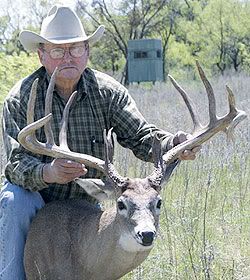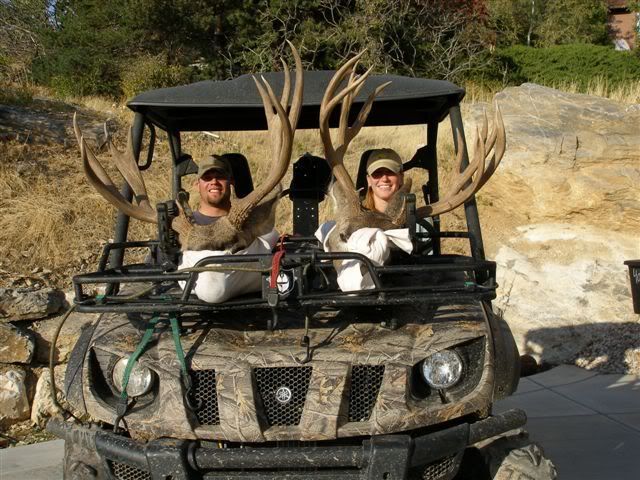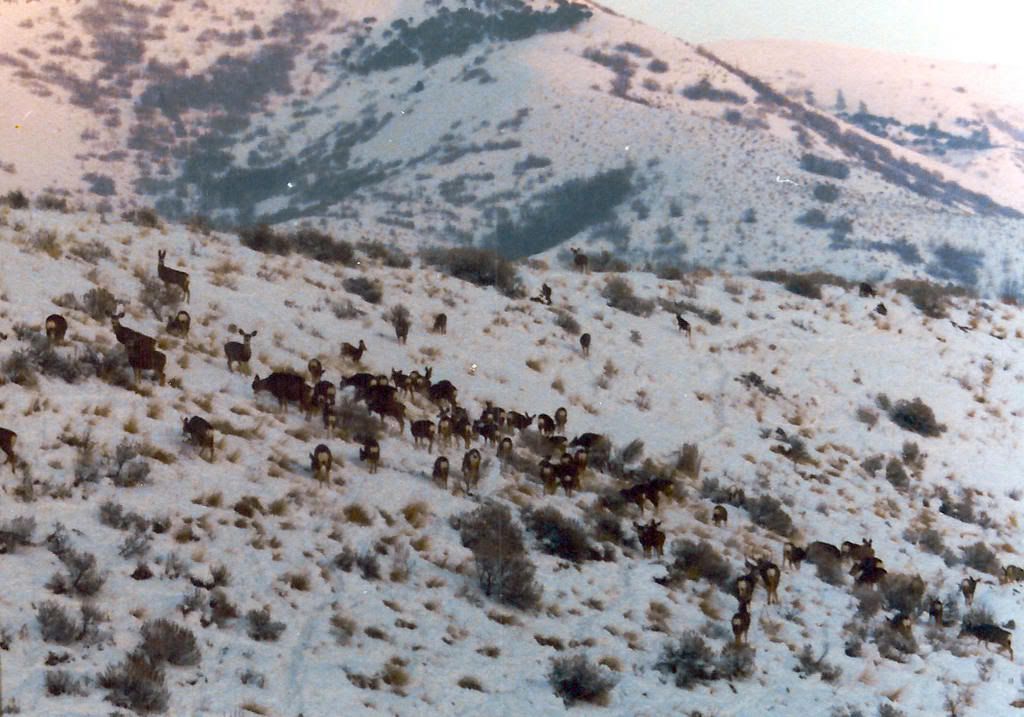Those Texans still can’t tell the difference between a Mule Deer and a Whitetail.

Bud Dearing, age 77, kills big mule deer on his own ranch.
Those Texans still can’t tell the difference between a Mule Deer and a Whitetail.

Bud Dearing, age 77, kills big mule deer on his own ranch.


BearPaw Outfitters of Alberta, Canada
These guys are pricey, but they produce.
Here are some links I think you will want to look at:

As reported by the Reno Gazette:
NDOW notebook: Black mule deer spotted in Winnemucca
Posted: 11/16/2007
We have our fair share of wildlife legends here in the West. Bigfoot has been spotted all over the Pacific Northwest and Tahoe Tessie is seen from time to time patrolling the waters up at Lake Tahoe.
So when locals in Winnemucca began reporting sightings of a solid black mule deer, some people may have started to get their nicknames ready for the next big legend of Nevada.
Mike Cox, big game biologist at the Nevada Department of Wildlife, has his own name for the phantom deer … he calls it a genetic alteration.
“It looks like it fell into an oil spill, but obviously we don’t have those in the middle of Nevada,” Cox said. “There are genes that map out the characteristics of an animal in its embryonic stage. Sometimes it’s a funky hoof, or a tweaked antler, or in this case the hairs of this mule deer are a different color than the normal mule. Sometimes there are recessive traits that are hidden in those genes that never see the light of day except for maybe one in a million, or one in two million.”
NDOW biologist Ed Partee states that black mule deer have been spotted before in Nevada.
“We have seen these black deer in the past in Humboldt County, mainly in the Jacksons, but we haven’t seen it for quite some time,” said Partee.
Cox reports that there appears to be nothing else out of the ordinary with the black mule deer doe other than its striking color.
“It’s definitely unusual. We may never see it again for a generation, or 50 years, or we may see it next year,” said Cox. “It’s almost like slot machines. You have to pull that slot machine a long, long time until you get the right combination, and that’s what happened with this melanistic mutation.”
Unfortunately, I don’t know the story behind this photo which was emailed to me, but these are a couple of dandy Wyoming Monster Muley Bucks from the 2007 season.

“Sustaining populations subjected to hunting pressure requires species capable of rapid and consistent reproduction. Deer qualify.“

The above quote comes from Dr. Scott Shalaway of West Virginia.
I am open to discussion or to contention in regards to what I am about to say, but here is what I believe:
First, the earth was created. The earth, mule deer, predators, people…. they didn’t just happen. I believe the creator had humans foremost in his mind and that humans are “factored in” to how the earth functions. Humans are “natural”. In fact, the primary purpose of the earth is for humans. What does this have to do with the price of cheese? It is a long story.
Secondly, there are prey and there are predators. Relative to mule deer – human hunters are part of the predator group. Hunting mule deer for food and/or for whatever other reason, has been happening for a long time. As humans, we can decide whether or not our needs, wants, and desires for mule deer consumption are a higher or lower priority than those of the other predators, i.e., lions, wolves, bears, coyotes.
I believe that the creation of the earth is such that, in the absence of human predators ( for whatever reason ) predators and prey have some pre-defined balances which keep prey populations from getting too large. This balancing act is not perfect in the sense that prey never exceed carrying capacity, but it serves the purpose overall without divine intervention. We humans both interfere with that balance and control it. To state this bluntly, we can have as many deer as we want, as long as we like the consequences.
When we humans decide that we need more prey ( such as mule deer ), then we simply reduce the other predator populations and wala population explosion. Then, we are the control instead of the other predators. This is how we provide for hunting. This is what game management is all about ( or supposed to be about ). Mule deer aren’t quite as prolific as rabbits, but almost. Overall, twins are the norm.
So without factoring in death, deer populations go like this: Adam and Eve buck and doe have two fawns, male and female. The next year, Adam and Eve have two more. The next year, Adam and Eve have their two, and daughter#1 has one. The next year Adam and Eve have two, daughter#1 has two, daughter#2 has one, and grand-daughter#1 has one. And so on and so forth. Assuming I am doing the math correctly: by year, the population looks like this: 2 -> 4 -> 7 ->13 ->24. This is not exactly linear and not exactly exponential, but you get the idea.
I don’t know how my dad figured it out, but in my youth he did not want me killing does, and told me that, if I killed a doe – I would be killing the equivalent of 25 deer in five years. He was about right.
Thirdly, if our game “managers” took the right actions, we could have mule deer ( or rabbits, quail, grouse, whatever ) coming out of our ears. We would control these populations by hunting ( as in the good ol’ days ) vs. by employing the other predators. Game managers are, more and more, moving toward putting human hunters last on their list of priorities, but it doesn’t have to be that way. The agencies need to hear from us loud and clear “we want and expect more game”, if in fact, that is what we want and expect. We are, after all, paying the bill.
This article came from Vindy.com in Youngstown, Ohio:
I am going to do a series of posts about this topic and use this article as a foundation for those posts
——————————————
Published: Saturday, November 17, 2007
Sustaining populations subjected to hunting pressure requires species capable of rapid and consistent reproduction. Deer qualify. Over the last century, studies of deer biology and its response to hunting pressure have resulted in thousands of research papers, books, symposia and countless graduate degrees in wildlife biology.
Two classic cases, familiar to every wildlife biologist, stand out as the foundation of deer management in North America.
From 1906 through 1923, government hunters and trappers removed predators from the Kaibab Plateau along the north rim of Arizona’s Grand Canyon. During that period, agents removed 781 mountain lions, 30 gray wolves, 4,889 coyotes and 354 bobcats.
The Kaibab mule deer population responded in spectacular fashion. When predator control began, the mule deer population was estimated to be 4,000. Under greatly reduced predator pressure, the deer herd exploded to more than 100,000 in less than 20 years. During the winter of 1924-25, the population crashed. Ever since, wildlife biologists consider “Kaibab Plateau” to be synonymous with the dangers of predator control as a way to protect game populations.
Rarely, however, is population biology so simple. In 1970, Graeme Caughley suggested that the mule deer population explosion on the Kaibab Plateau was due more to the recovery of the range than to the disappearance of predators. It turns out that while predators were being removed from the area, so were domestic livestock. At least 200,000 sheep and 20,000 cattle were removed at the same time the predators were being removed.
Caughley argues that deer flourished not because predators disappeared, but because the recovering range provided a virtually unlimited food source. We’ll probably never know which factor was more important, but a case can be made that both predator control and unlimited food can trigger a population explosion.
Just a few years after the Kaibab “experiment,” another classic field study unfolded. In the 1920s a Detroit industrialist, Col. Edwin S. George, purchased 12 adjoining farms, a total of 1,146 acres, in southern Michigan. In 1930 he donated the property to the University of Michigan for use as a natural laboratory, though he maintained one house and 40 acres for his personal use. After George’s death in 1940, his heirs gave complete ownership and control to the university.
In the 1920s there were virtually no deer in southern Michigan. In 1927 Colonel George erected a 7.5-foot-high fence around the entire site, and the following year, he released six white-tailed deer, two males and four females, inside what today is known as the George Reserve. The deer were trapped on Grand Island in Lake Superior, and the does were thought to be pregnant.
The George Reserve deer herd thrived. Six years later in 1933, biologists conducted the first annual deer drive census to assess the population. They counted 130 deer; in six years the population grew from six to 130, an astounding rate of population growth.
Since that initial deer drive census, this deer population has been intensively studied and manipulated. Various rates of hunting pressure enabled biologists to study and evaluate white-tailed deer population growth under a variety of conditions. Dale McCullough, a University of Michigan professor, published the results of decades of research in “The George Reserve Deer Herd” (1979, University of Michigan Press).
The results of the Kaibab and George Reserve field experiments demonstrated that deer populations, when provided with quality habitat and minimal predation, can grow explosively. Biologists call this exponential population growth. Theoretically, all species grow exponentially until they reach limits imposed by the environment (habitat quality, food availability, space, predator pressure, etc.). Reproductive characteristics such as gestation period, litter size, litters per year, and age at first breeding determine how quickly such a population explosion can occur.
The innate reproductive capacity of deer and other game species is the biological basis for annual harvests. By monitoring population numbers and habitat quality, biologists can adjust hunting pressure on game species annually as populations fluctuate.
Clearly, wildlife management is complicated. This is probably the best reason politicians, unschooled in population biology, should resist the urge to meddle and allow professional biologists to do their jobs.
Send questions and comments to Dr. Scott Shalaway, R.D. 5, Cameron, WV 26033 or via e-mail to sshalaway@aol.com.
Last Update/Review: August 12, 2002
Attention Canadian Hunters!As of January 1, 2001, federal law requires firearms owners to be licensed. You must carry on your person a valid federal firearms licence or a valid federal Firearms Acquisition Certificate (FAC) to use or transport non-restricted firearms. As of January 1, 2003, federal law requires that all firearms be registered. As of that date, you must carry on your person a valid registration certificate for each firearm you are using or transporting. Go to Justice Canada’s Canadian Firearms Centre for more information and firearms licensing and registration. Note: A federal firearms licence or FAC is not required to purchase provincial hunting licences.
Attention Non-resident Alien Hunters!All firearms must be declared upon entry into Canada. See below. |
The following is a summary interpretation of some of the federal firearms legislation as it pertains to sport hunting. For further information about federal firearms laws and regulations, contact your local police service, or the Canadian Firearms Centre — telephone toll free, 1-800-731-4000.
Federal regulations allow the use of firearms for specified activities that include hunting. The possession of a loaded firearm is lawful, however, only in a location where the firearm may be discharged in accordance with any applicable federal and provincial acts and regulations, and municipal bylaws.
A person 12 to 17 years of age must obtain a Minor’s Licence to use non-restricted firearms, such as rifles and shotguns, for hunting, target practice, firearms instruction or taking part in an organized shooting competition. The parent or legal guardian of the minor must give consent to the issuing of the licence. Note: a minor’s licence does not permit the holder to acquire (buy, inherit, receive as a gift or take in trade) firearms.
A licence is not required if a person, lawfully in possession of a firearm, allows a minor to use the firearm, in the same manner as the person is allowed to use it, and the minor is under the person’s immediate supervision.
A person who is authorized to have a non-restricted firearm may transport the firearm in a vehicle if the firearm is unloaded. A person may transport a non-restricted firearm by other means of conveyance (e.g., on an off-highway vehicle) provided it is unloaded and it is not left unattended if the vehicle cannot be locked.
All firearms must be declared upon entry into Canada. Canada Customs requires the declaration be made in writing and charges a fee of $50 Cdn. This declaration is valid for 60 days. All pistols, revolvers and automatic firearms are restricted or prohibited weapons and may not be brought into Canada for hunting purposes.
If a firearm is left in an unattended vehicle, the firearm must be secured in a locked trunk or similar compartment. If the vehicle has no such compartment, the firearm must be stored in the vehicle out of sight (not visible from outside the vehicle), and the vehicle or compartment containing the firearm must be securely locked.
A person must store a firearm unloaded and in a secured manner to ensure that it will not be readily available for use in a careless manner.
Unloaded, as it relates to a firearm, means that any propellant powder, projectile or cartridge that is capable of being discharged from the firearm is not contained in the breech or firing chamber or in a cartridge magazine attached to or inserted into the firearm.
The only exemptions are muzzle-loading, non-restricted firearms (e.g., a muzzle-loading rifle or muzzle-loading shotgun that is lawful for hunting under the Wildlife Act) which may be transported loaded between hunting sites provided that the firing cap or flint is removed. —————————–
If you live in the United States, you may be surprised about the manner in which mule deer hunting is handled in Alberta, Canada. Alberta is divided into five big game zones: the mountain zone in the west, the foothill zone to the east of the mountain zone, the parkland zone to the east of the foothill zone, the boreal zone in the north, and the sm all southern plains zone.
all southern plains zone.
It may surprise you to know that there are some real bruisers in the southern plains. In Alberta, outfitters may control 10% of the available tags. Tags aren’t abundant anywhere, but especially on the southern plains, consequently Muley bucks can grow to trophy class.
Another surprise for you, may be the fact that the prarie hunting season is four weeks long, but you may only hunt from Thursday through Saturday of each week. Now, that’s interesting, don’t you think? The deer get a breather, and they may not know if it’s hunting season or not.
This year, 2007, both Alberta and Montana are having unusually warm weather which is impacting the deer harvest in a negative way. If the mild weather continues through the winter though, it should make for better hunting next year.
Mule deer are found throughout the province, but are most plentiful in southern and western Alberta. They are more common in mountainous areas than white-tailed deer. The Fish and Wildlife Division estimates the provincial population (in Sept.) to be about 133,000 animals. This estimate is based on population counts in selected areas and hunter harvest information.
| Region | Archery | General |
| Boreal | late Aug. to late Oct. |
early Sept. to late Nov. |
| Mountains | late Aug. to late Nov. |
mid Sept. to late Nov. |
| Foothills | late Aug. to late Oct. |
mid Sept. to late Nov. |
| Parkland | early Sept. to late Nov. |
November |
| Prairie | early Sept. to early Nov. |
November |

Mild weather in Montana is being blamed for a low mule deer harvest in 2007. Without snow in the high country, mule deer are not aggregating in the low, more accessible, country. Because Montana hunters can, and do, hunt multiple species at one time, it is difficult to assess mule deer success in and of itself. For example, this year, in west central Montana, it took over 11,000 hunters to come up with about 240 mule deer. In the northwest it took 12,000 hunters to harvest only 130 mule deer. In the southwest, the numbers are 2700 hunters to bag 125 mule deer.
One possible bright spot is that next years’ harvest could improve. If winter doesn’t take too much of a toll, there will be more animals for next year.